Established 1921
1921
R G Carter was founded by Robert George Carter.
Prior to the First World War, he had trained and worked as a carpenter, and following his time with the Royal Engineers, he worked with a large building firm as a general foreman. By 1921 he had established his own business, starting with the building of local housing.
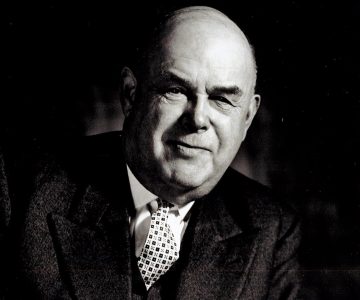
1922
The Firm’s founding office was located in R G Carter’s former carpenter’s workshop on Low Road, in the Norfolk village of Drayton.
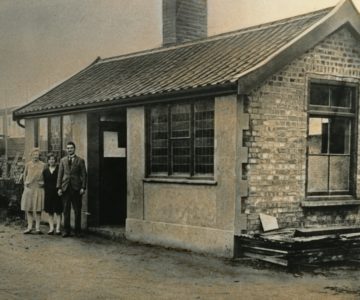
1923
The first major contract undertaken by the Firm, was for the Norwich City Corporation, to construct 300 homes on the Mile Cross Council Estate, Norwich.
This estate and others were built as part of the UK housing scheme ‘Homes for Heroes’, offering better living conditions for returning soldiers.
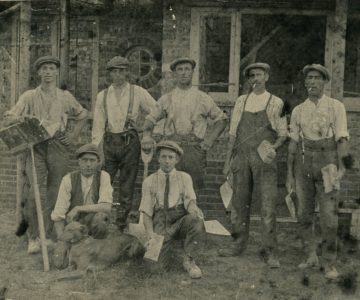
1928
It was in this year, that R G Carter was first listed in the Norwich Telephone Directory.
The telephone number for the founding office was “Drayton 16”.
Following the First World War, the Firm constructed many new public houses as demand increased for places where ex-servicemen and women could meet and socialise.
This example of the site team at The Constitution in Norwich in the early 1930’s, is one of the many fine public houses the company built.
What is special about this photograph is that the father of our Chairman Robert Carter, can be seen standing to the right of the ladder in his uniform on his way back from school.
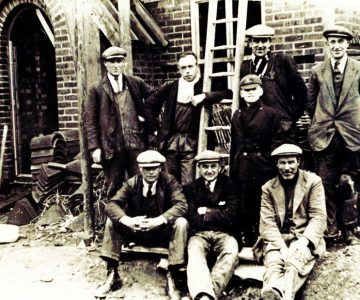
1932
The Artichoke public house; still open today and one of the most recognisable pubs built by R G Carter.
Other examples in Norwich include Constitution Tavern on Constitution Hill, and The Barn, at the foot of Grapes Hill.
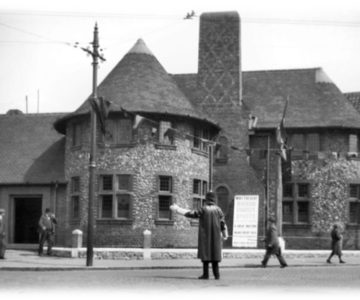
1935
R G Carter purchased Herbert Bullen & Son Ltd. of Cromer, an established building business with joinery shop.
Post WWII
Contracted to help build a series of prefabricated buildings across Norfolk, R G Carter helped to provide urgent temporary homes for the community after WWII.
The work was part of Churchill’s temporary housing programme, the Emergency Factory Made Scheme ( EFMS ), for returning British soldiers and homeless families.
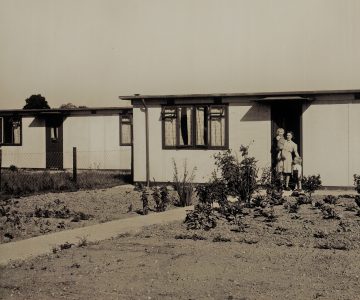
This eclectic scattering of vintage vehicles in the mid 1940’s, captures one of many site clearances that took place across the city of Norwich after the Baekdeker raids in 1942.
A Fordson 7V truck can be seen front left, as well as a hand-made bespoke workman’s tool trailer to the right, both with R G Carter branding.
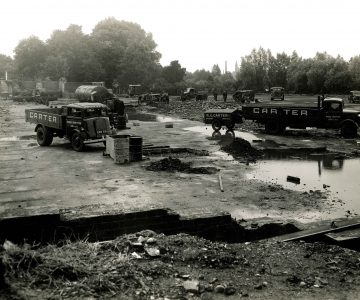
1945
Damage caused in WWII across Norwich and its outskirts, led to a huge demand for new housing for the community. At one stage R G Carter were handing over houses at the rate of one per day!
Here is a brick laying ceremony at the first 16 homes on the Silfield Road Housing scheme near Wymondham in 1945.
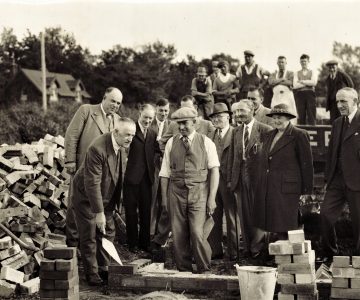
1946
In this year, R G Carter celebrated it’s Silver Jubilee.
To commemorate this, the Firm held a formal dinner, which also celebrated the welcome home for returning soldiers.
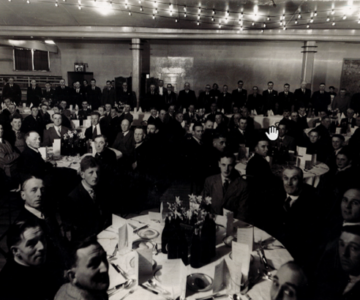
By the late 1940’s, R G Carter had started to deliver the new post-war modernist architectural styles emerging, coupling practicality with visual flair.
This striking red brick example shows Swan Laundry on Heigham Street, Norwich, part of the largest laundry facility in Norfolk.
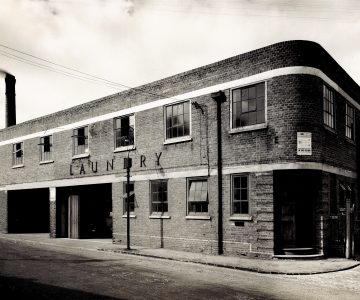
The restoration of the 15th century Watergate at Pulls Ferry, one of the most famous landmarks in Norwich, was a prestigious and important project for the skilled craftsmen at R G Carter.
Unscathed by the war but in a terrible state of disrepair, this last surviving old city gateway saw a complete transformation in the late 1940’s. R G Carter proudly restored the house, archway and turret to its former glory.
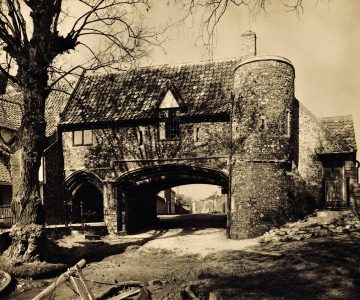
1949
R G Carter relocated to larger purpose built buildings on Drayton High Road in Norwich.
The site remains the company’s registered office and home to R G Carter Ltd, our Drayton team.
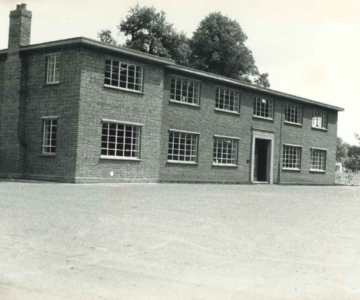
1950
On the 18th December, Bob Carter, son of the founder of the Firm, became Managing Director of R G Carter Ltd.
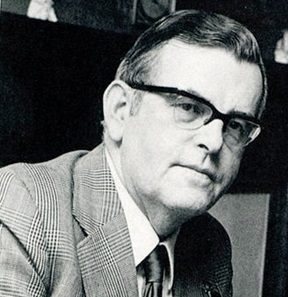
1951
Further to the completion of the Firm’s prestigious work at the Colman Galleries at Norwich Castle Museum, Mr. R. G. Carter had the honour of meeting Princess Elizabeth. The following year she became Her Majesty The Queen.
The greeting seen in this picture was taken in the open air courtyard of the Castle, before the Rotunda was built by R G Carter, later in 1969.
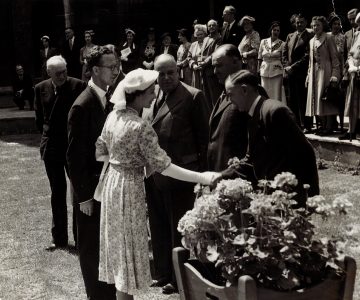
1954
One of the many buildings in Norwich destroyed by bombs in WWII, was Morgan’s Brewery in King Street; a client that R G Carter had already built a solid relationship with before the war.
Here the founder and a Morgan’s supervisor can be seen on the roof of the new brewery building, rebuilt at the same location.
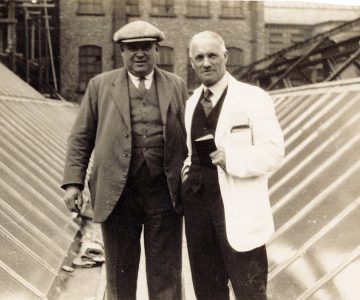
By 1955
R G Carter were now the largest building company in Norfolk, and ran subsidiaries including Bullens, Fishers, Blackburns and Drayton Stone Pits.
1956
The first tower crane used by R G Carter was deployed on the new office building for Laurence & Scott Electromotors in Norwich.
Director Billy Hunter remembers in his records that “No one wanted to go out along the jib, as it was just so high!”.
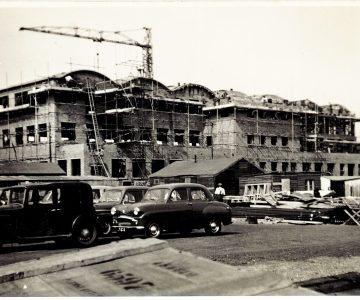
1957
The Firm’s first multi-million contract, was a factory built in King’s Lynn, Norfolk, for famous soup brand Campbell’s.
The first office in King’s Lynn opened alongside this contract.
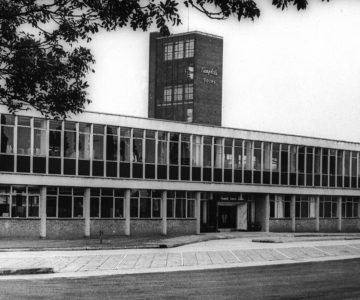
1958
This moment shows Mr. R. G. Carter with Norwich Union’s Estate Manger and the architect, going over the initial plans for the demolition required for Phase 1 of the Island site constructed for Norwich Union in 1958.
This was part of the redevelopment of central Norwich to create office space in their rapid expansion, which lasted many decades.
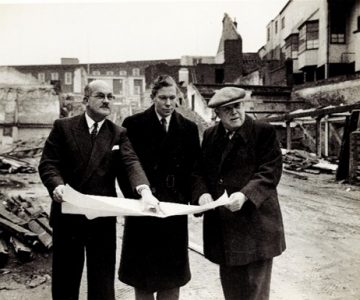
1959
This iconic image of Mr. R. G. Carter ran in an article in the Eastern Daily Press on 15th October, 1959.
In a specially made metal chair attached to the jib of a crane, 100ft high, he landed on the 7th floor of the new Norwich Union office block to visit his team on site.
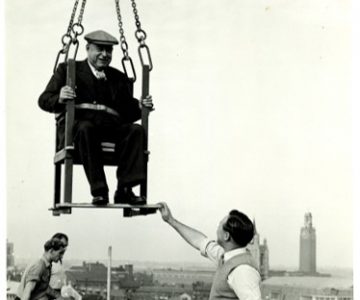
1962
The Firm built on the Inner Harbour at Lowestoft, a 75m high concrete grain silo for Associated British Ports.
This new facility had a huge capacity of 13,500 tonnes to support this Eastern port’s important role in cargo handling.
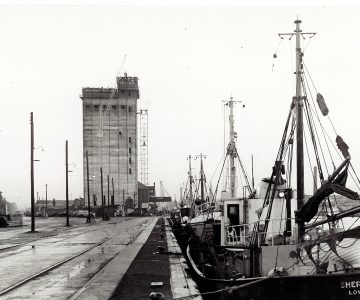
1963
The early 1960’s, saw the start of a long lasting client relationship with the University of East Anglia, starting with the building of educational blocks, a medical centre, banks, shops and offices.
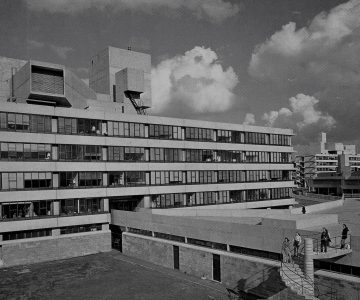
1968
Bob Carter, due to a passion for supporting employees and developing a skilled workforce, appointed the first Group Training Officer to place focus on company training and to create a comprehensive Group Training Scheme.
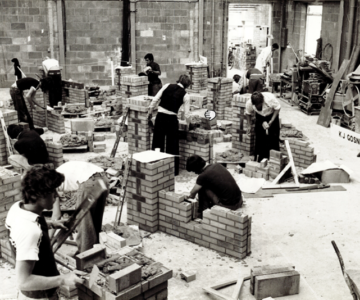
1969
Norfolk County Hall was built on Martineau Lane, Norwich; this office development involved staff housing in an old mansion on site, and a research building.
Mr. R. E. Carter, son of the founder, proudly greeted Her Majesty The Queen the official opening of the building.
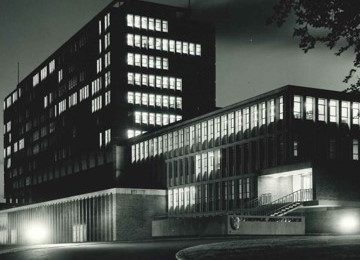
1970
The R G Carter Group acquired John Youngs, a Norwich-based building company.
John Youngs and Son founded in the mid-19th century and were renowned builders of many prestigious landmarks in the City of Norwich, including Thorpe Station, The Royal Hotel and the Royal Arcade.
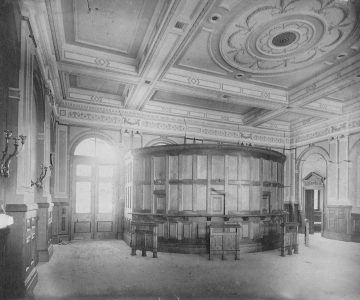
1971
R G Carter proudly celebrates 50 years of success, in its Golden Jubilee.
1971
On the 15th September 1971, a topping out was held on the roof of Norfolk Tower; part of the Norwich Union development under construction in the city. It was the city’s tallest office block at the time at 11 storeys high.
Mr R. E. Carter can be seen here left, celebrating the occasion by dousing the roof in champagne.
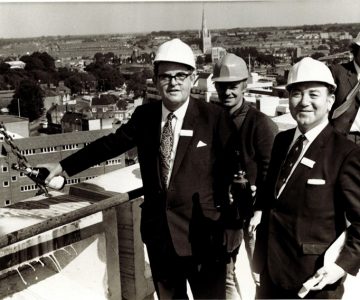
1972
Due to the expansion of Blackburns into commercial and industrial work, the first office in Ipswich was opened.
1973
Boughton Builders of Thetford became R G Carter Thetford.
1976
The R. E. Carter Awards were an annual celebration of the amazing skills of craft apprentices from all across the Norfolk and Waveney region, founded in 1976.
This images shows the apprentices that represented R G Carter in 1977 at an informal reception, Chairman Robert Carter, second left, presenting three apprentices with their gold medals.
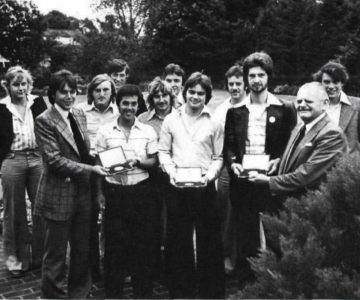
1978
R G Carter constructed the first major building designed by architect Sir Norman Foster, The Sainsbury Centre for Visual Arts, located at the University of East Anglia.
The building won several awards, including Ambrose Congreve Award for Architecture.
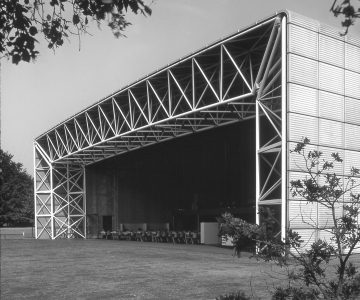
1979
Norwich City Football Club stadium stands The River End, was completed.
R G Carter went on to build all four main stands and corner links across the next two decades; City Stand ( 1988 ), Barclay Stand ( 1992 ) and South Stand ( 2004 ), which replaces that first built by the company in 1935.
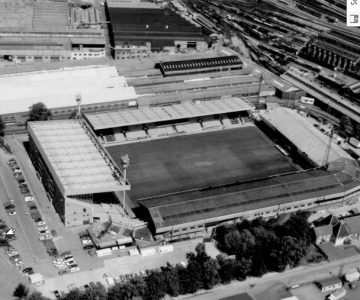
The company started to develop expertise in the retail sector, winning contracts for a variety of major retail stores and supermarkets, as expansion and store sizes began to increase across the UK.
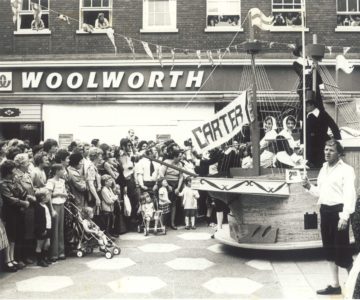
1981
Robert Carter becomes Group Chairman.
Son of Bob Carter, the former Chairman, believed that the company’s strength was its building expertise, skilled work force and trustworthy reputation.
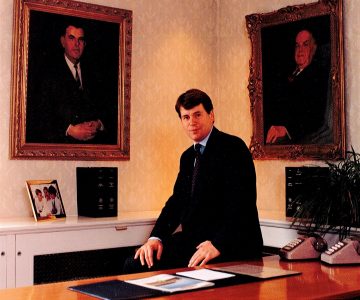
1983
The first R G Carter office in Peterborough was opened.
1983
The largest single span aircraft hangar in Europe was built for Marshall at Cambridge Airport.
Later in the summer of 2000, the company also built the new control tower.
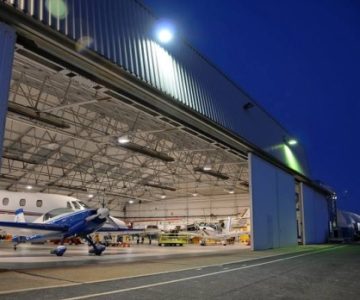
1988
This space-like complex, Norwich Sports Village, was the first of its kind to be built in this country. Designed by Swiss engineer Heinz Isler, these free-form, reinforced concrete shells were created to house indoor tennis courts for a new sports complex.
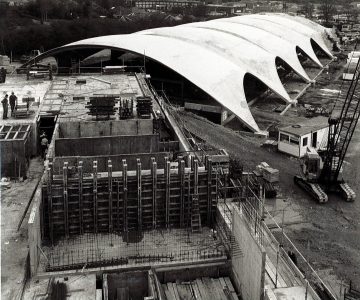
1990’s
The rise in Business Parks in the decade, led to the development of many projects in Norfolk, including Norwich Business Park, St Andrews Business Park and Longwater Business Park.
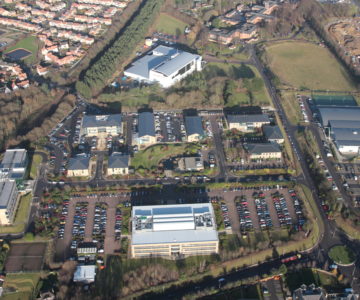
1992
The refurbishment of Maitland Robinson Library at Downing College was completed, with a new library built at St John’s College to create more space for the many valuable books and manuscripts in the collection.
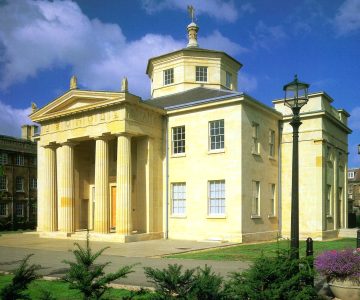
1996
R G Carter delivered the largest high-bay coldstore in Europe for Frigoscania, with a volume of 6,820,000 ft3 and standing 33 metres high.
This Grimsby frozen distribution centre was built ‘inside out’, its internal storage racking system clad to create storage for over 33,000 pallets.
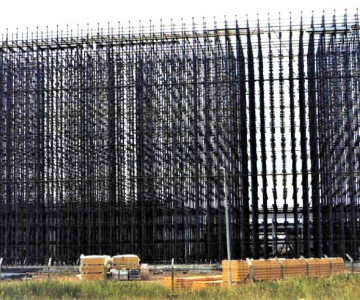
2001
The official opening was held for the award-winning Norfolk and Norwich Millennium Forum, designed by Michael Hopkins and Partners.
This city landmark was built to replace the original library, destroyed by fire in 1994 and opened by Her Majesty The Queen, in her Golden Jubilee year.
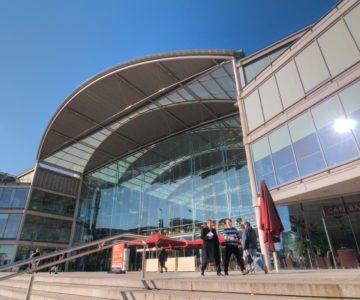
2004
Norwich Cathedral awarded the build of its new Refectory to R G Carter, the most significant structure added to the building since the middle ages.
Designed by Hopkins and Partners, the building was praised by the Fine Art Commission for grafting the future on to the past, enhancing not harming it.
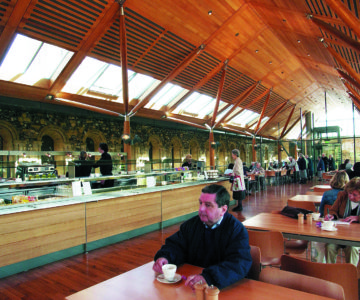
2005
The new offices for R G Carter Projects Limited were built on the site at Bury St Edmunds, where they had been operating since 1985.
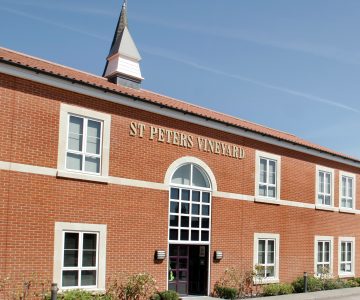
2006
The Firm’s in-house training centre becomes Carter Academy, its location remaining at the original founding location on Low Road, in the village of Drayton, Norfolk.
2008
Environmentally Award winning EPIC centre, was completed at the Lincolnshire Showground for the Lincolnshire Agricultural Society.
This project demonstrated key green credentials, allowing visitors to explore new technologies and learn about the benefits of developing a low carbon world.
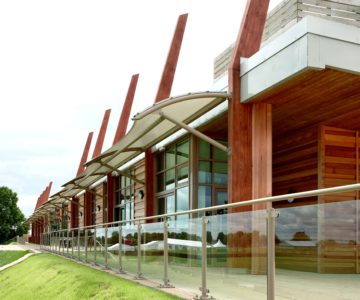
2009
Fisher & Sons (Fakenham) Limited merged with H.Bullen & Sons (Cromer), to become Fisher Bullen Limited.
2010
Norwich City’s Grade II listed War Memorial was refurbished for Norwich City Council, located in the centre of the city, facing the historic Norwich City Hall and the iconic market place.
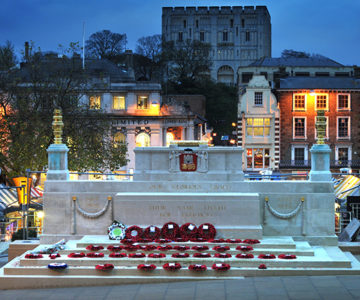
2011
The first R G Carter office in Northampton was opened.
2016
King’s Lynn Innovation Centre ( KLIC ) was completed, and became home to new and growing businesses; the largest brownfield regeneration project ever handled in West Norfolk.
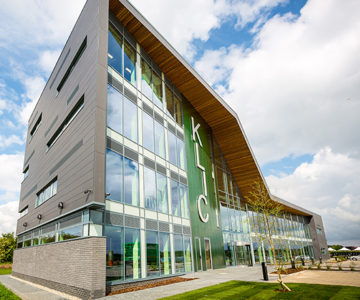
2016
At the University of East Anglia, R G Carter completed the 514-bed residential development, known to students as Barton and Hickling House.
The building comprises of two residential blocks, arranged around a central courtyard, with a café, launderette and office provision.
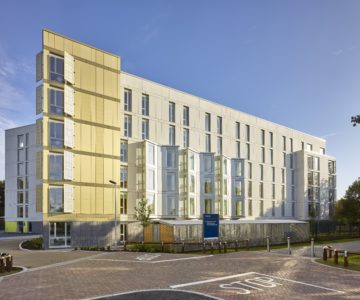
2017
The Aerospace Integrated Research Centre for Cranfield University, was completed. ARIC partnered with Rolls-Royce and Airbus to help provide these high-spec new facilities.
New offices were built in Chelmsford, its first premises in the county of Essex.
Attleborough in Norfolk, became home to R G Carter Engineering, in a new purpose built facility for R G Carter Civil Engineering, GM Piling and Ground Technology Services.
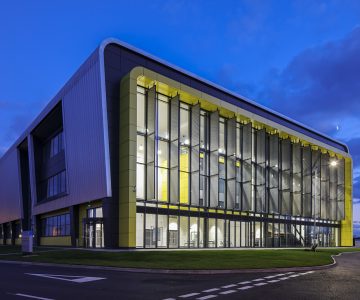
2018
The historic University Arms Hotel, at Parker’s Piece in Cambridge, opened the doors to its first customers, after an extension and refurbishment of the existing 1920s and 1900s hotel.
Showcasing many traditional skills, the completed project provided Cambridge’s oldest hotel with 192 bedrooms, a library, bar, function rooms and restaurant.
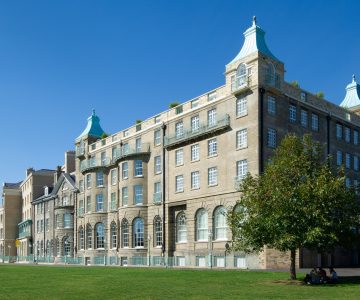
2019
Goldsmith Street in Norwich, won the coveted Royal Institute of British Architects (RIBA) Stirling Prize, awarded to the UK’s best building.
An exemplar Passivhaus residential development, the largest in the UK in this year, the scheme re-imagined the Victorian terraced street for the twenty-first century.
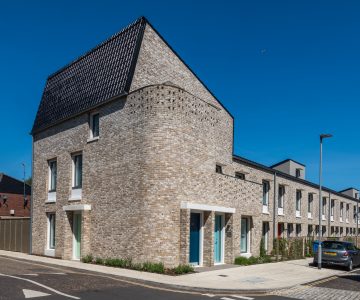
2020
The Winerack is a project we are immensely proud of.
Standing as one of the tallest residential buildings in Ipswich, this landmark development provides 150 new apartments with stunning views across the river Orwell as well as 5,000 square feet of commercial space.
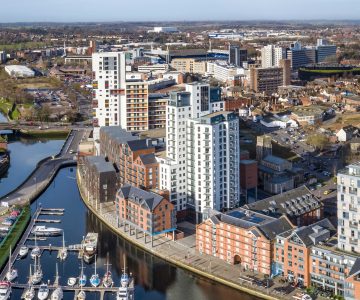
2021
The Centenary year of R G Carter.
Designed as a retro stamp, this new logo was created to represent the establishing year that R G Carter began and stands as a reminder of the amazing achievements delivered by all employees, past and present, in the Firm’s first 100 years.
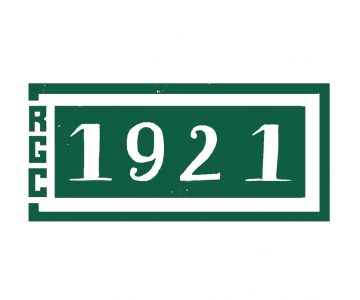
2021
R G Carter gifted an eight acre parcel of land to Priscilla Bacon Hospice, to build their new state of the art facility.
The deeds for this centenary gift were officially handed over by Robert Carter to Lady Bacon, Patron of the PBH, on the site located near the Norfolk and Norwich University Hospital.
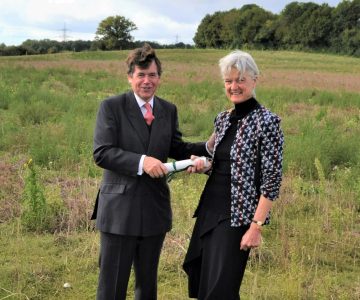
2022
The award-winning Digi-Tech Factory was built to bring together City College Norwich’s digital skill’s provision into a single purpose built space.
Its striking, unique architectural design included a saw tooth roof and perforated metal cladding, patterned with digital and binary code sequences to reflect the theme.
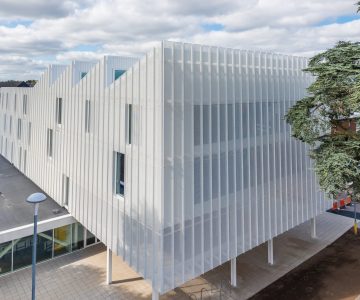
2023
The South Lincolnshire Food Enterprise Zone (FEZ Hub) was built as a start-up space for SME’s with workshops and offices, offering tenants a specialised, collaborative environment for businesses to share ideas and be at the heart of innovation in the agricultural-tech industry.
The project won both a Greater Lincolnshire Construction and Property Award, as well as an LABC Building Excellence Award.


